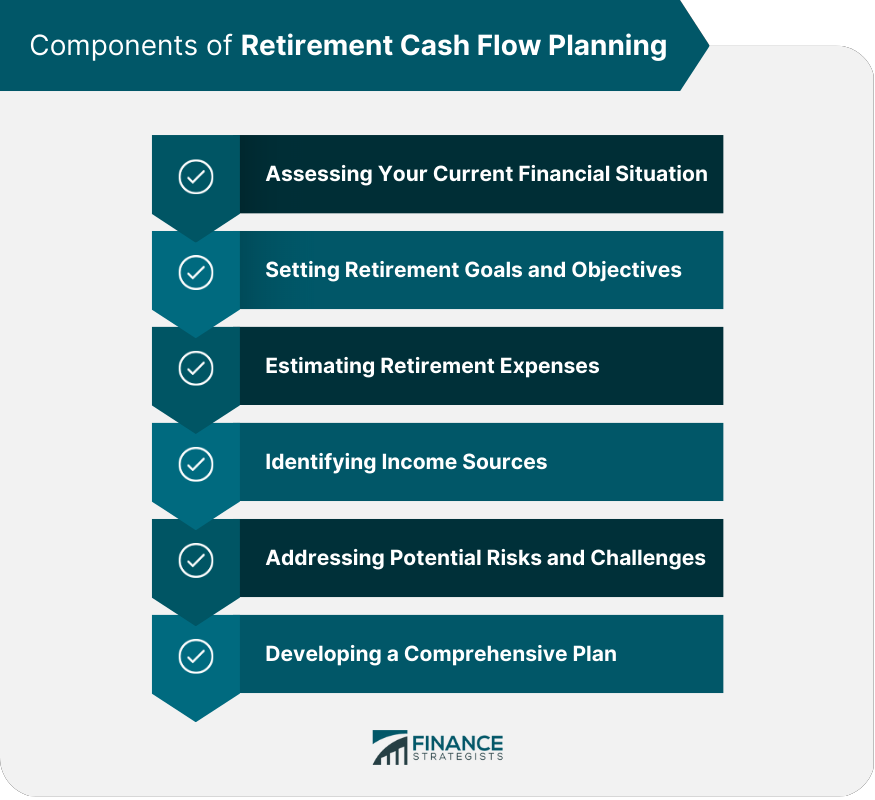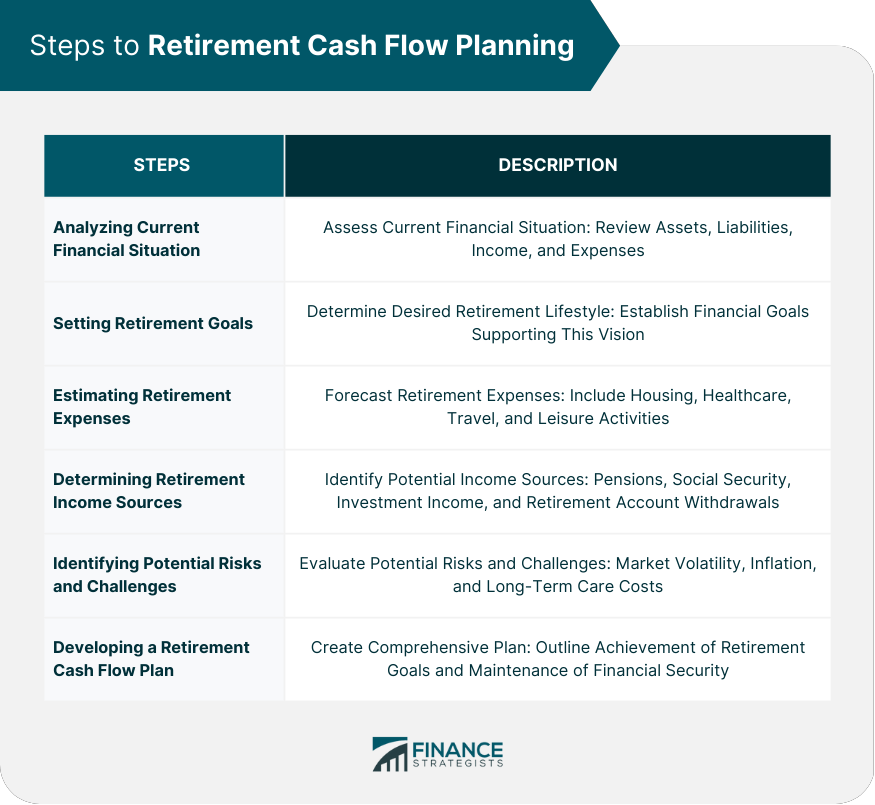Retirement cash flow planning is the process of analyzing your current financial situation, setting retirement goals, and devising strategies to ensure a consistent and reliable income during your retirement years. This planning involves estimating the sources of retirement income, such as Social Security benefits, pensions, investment income, and retirement savings, and comparing them with anticipated expenses, including housing, healthcare, travel, and daily living expenses. The goal is to create a sustainable financial plan that allows retirees to enjoy their retirement years without the fear of running out of money. Retirement cash flow planning is a complex process that involves multiple components. Each component plays a crucial role in helping you achieve financial security during your retirement years. Here, we will elaborate on the key components of retirement cash flow planning. Understanding your current financial situation is the foundation for effective retirement cash flow planning. This includes evaluating your assets, such as savings, investments, real estate, and other valuable possessions, as well as your liabilities, such as mortgage, loans, and credit card debt. Additionally, you should consider your current income and expenses to determine your financial capacity to save for retirement and make necessary adjustments to your lifestyle if needed. Defining your retirement goals and objectives helps you determine the lifestyle you want to maintain during retirement. Consider factors such as when you want to retire, the type of residence you would like to live in, whether you plan to travel or pursue hobbies, and any financial support you may need to provide for family members. By establishing clear goals, you can create a roadmap for achieving the retirement lifestyle you envision. A crucial part of retirement cash flow planning is estimating the expenses you will incur during your retirement years. These expenses can include housing (mortgage or rent payments, taxes, maintenance, and utilities), healthcare (insurance premiums, out-of-pocket costs, and long-term care), daily living expenses (groceries, transportation, insurance), and discretionary expenses (travel, hobbies, entertainment). Accurate estimation of retirement expenses helps you determine the amount of income you will need to maintain your desired lifestyle. Once you have a clear understanding of your retirement expenses, it is essential to identify potential income sources to cover those expenses. Common income sources during retirement include: Social Security benefits Pensions Part-time or freelance work Rental income By diversifying your income sources, you can reduce the risk of financial hardship if one source becomes unreliable. Retirement cash flow planning also involves identifying and addressing potential risks and challenges that could impact your financial security. Some common risks and challenges include market volatility, inflation, increasing healthcare costs, changes in tax laws, and unexpected life events (such as the death of a spouse or a serious illness). Developing strategies to mitigate these risks can help you maintain your financial stability during retirement. The final component of retirement cash flow planning is developing a comprehensive plan that outlines the steps you will take to achieve your retirement goals and maintain financial security. This plan should detail your savings and investment strategies, asset allocation, Social Security claiming strategy, retirement account withdrawal strategies, long-term care planning, and any other relevant aspects of your financial life. By having a well-thought-out plan in place, you can ensure that you are prepared for your retirement years and able to enjoy the lifestyle you desire. Several factors must be taken into account when planning your retirement cash flow: Life expectancy Inflation rate Healthcare costs Taxes Desired lifestyle The first step is to assess your current financial situation by reviewing your assets, liabilities, income, and expenses. Determine your desired retirement lifestyle, and establish financial goals that support this vision. Forecast your expenses during retirement, including housing, healthcare, travel, and other leisure activities. Identify potential income sources, such as pensions, Social Security, investment income, and retirement account withdrawals. Evaluate potential risks and challenges, such as market volatility, inflation, and long-term care costs. Create a comprehensive plan that outlines how you will achieve your retirement goals and maintain financial security. Establish a budget that will help you manage your expenses and maintain your desired lifestyle throughout retirement. Develop a well-diversified investment portfolio tailored to your risk tolerance and financial goals. Maximize your Social Security benefits by choosing the appropriate claiming strategy. Develop a tax-efficient withdrawal strategy for your retirement accounts, such as 401(k)s and IRAs. Prepare for potential long-term care costs by considering insurance or other funding options. Effective cash flow planning helps to ensure you have enough income to cover your expenses during retirement. Having a solid plan in place can alleviate financial stress and anxiety related to retirement. Strategic planning can help you maximize your retirement income through investment, Social Security, and tax strategies. Proactively planning for your retirement can improve your overall financial well-being. Ensure you accurately estimate your expenses to avoid running out of funds during retirement. Be realistic about your income sources and do not rely on overly optimistic projections. Incorporate the effects of inflation when planning for retirement expenses and income. Account for healthcare costs, including Medicare premiums, out-of-pocket expenses, and long-term care. Diversify your income sources to reduce the risk of financial hardship in case one source becomes unreliable. Retirement cash flow planning is essential for ensuring financial security and maintaining your desired lifestyle during retirement. It involves analyzing your current financial situation, setting goals, estimating expenses, identifying income sources, addressing risks and challenges, and developing a comprehensive plan. By implementing effective strategies, such as budgeting, investment and asset allocation, Social Security optimization, and long-term care planning, you can maximize your retirement income and minimize financial stress. It is crucial to avoid common mistakes, such as underestimating expenses, overestimating income, and failing to account for inflation and healthcare costs. Diversifying your income sources is also important to mitigate risks. Remember, seeking professional guidance from a financial planner or advisor can help you create a customized retirement cash flow plan that meets your unique needs and objectives.What Is Retirement Cash Flow Planning?
Components of Retirement Cash Flow Planning
Assessing Your Current Financial Situation
Setting Retirement Goals and Objectives
Estimating Retirement Expenses
Identifying Income Sources
Addressing Potential Risks and Challenges
Developing a Comprehensive Plan

Factors to Consider in Retirement Cash Flow Planning
Steps to Retirement Cash Flow Planning
Analyzing Current Financial Situation
Setting Retirement Goals
Estimating Retirement Expenses
Determining Retirement Income Sources
Identifying Potential Risks and Challenges
Developing a Retirement Cash Flow Plan

Strategies for Retirement Cash Flow Planning
Budgeting and Expense Management
Investment and Asset Allocation Strategies
Social Security Optimization
Retirement Account Withdrawal Strategies
Long-Term Care Planning
Benefits of Retirement Cash Flow Planning
Ensuring Financial Security in Retirement
Reducing Financial Stress and Anxiety
Maximizing Retirement Income
Improving Overall Financial Health
Common Retirement Cash Flow Planning Mistakes to Avoid
Underestimating Retirement Expenses
Overestimating Retirement Income
Failing to Account for Inflation
Failing to Consider Healthcare Costs
Over-Reliance on a Single Income Source
Conclusion
Retirement Cash Flow Planning FAQs
Retirement cash flow planning is a process of estimating your future expenses and income during your retirement years to ensure that you have enough money to cover your living expenses and maintain your lifestyle.
Retirement cash flow planning is important because it helps you understand whether you have enough money saved to maintain your lifestyle during retirement. It also helps you identify areas where you need to adjust your spending or savings to meet your retirement goals.
To start Retirement cash flow planning, you need to estimate your future expenses and income during retirement, including your expected Social Security benefits, pension payments, and any other sources of retirement income. You should also consider factors such as inflation, taxes, and healthcare costs.
Retirement cash flow planning strategies include saving as much as possible for retirement, creating a budget to control spending, maximizing Social Security benefits, and considering investment options such as annuities or mutual funds.
It is recommended to start Retirement cash flow planning as early as possible. The earlier you start, the more time you have to save and invest, and the more flexibility you have to adjust your retirement plans as needed. However, it is never too late to start planning for retirement cash flow.
True Tamplin is a published author, public speaker, CEO of UpDigital, and founder of Finance Strategists.
True is a Certified Educator in Personal Finance (CEPF®), author of The Handy Financial Ratios Guide, a member of the Society for Advancing Business Editing and Writing, contributes to his financial education site, Finance Strategists, and has spoken to various financial communities such as the CFA Institute, as well as university students like his Alma mater, Biola University, where he received a bachelor of science in business and data analytics.
To learn more about True, visit his personal website or view his author profiles on Amazon, Nasdaq and Forbes.











